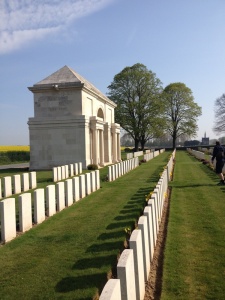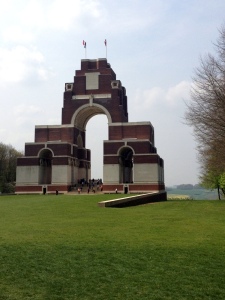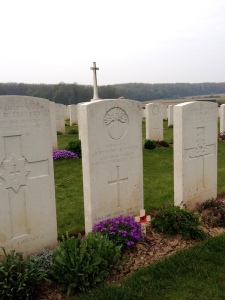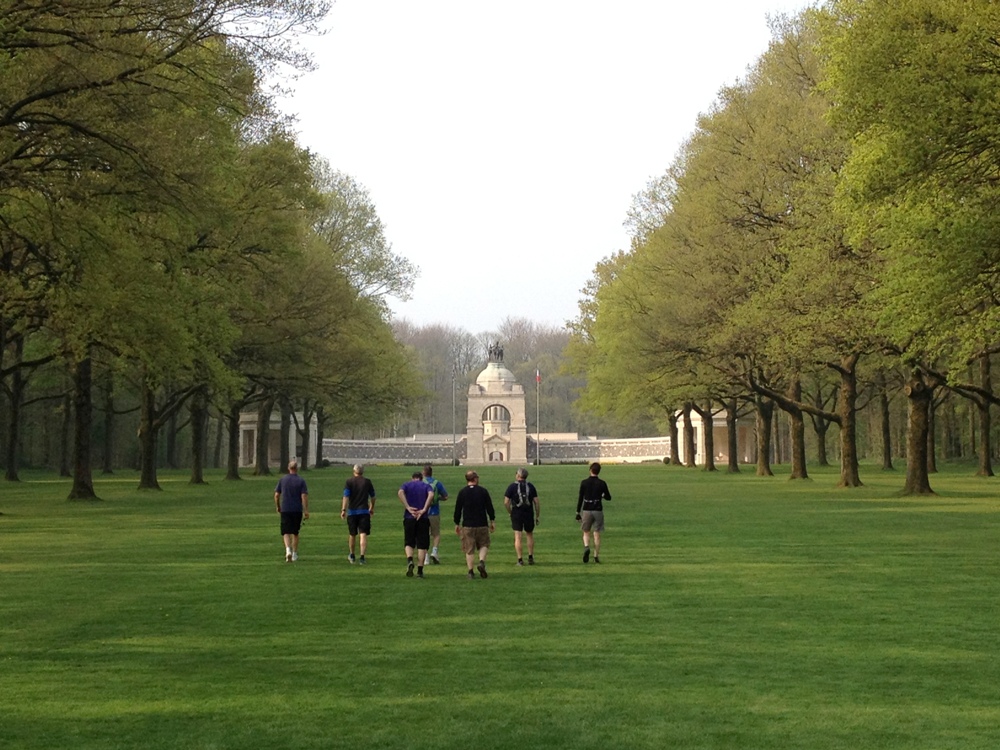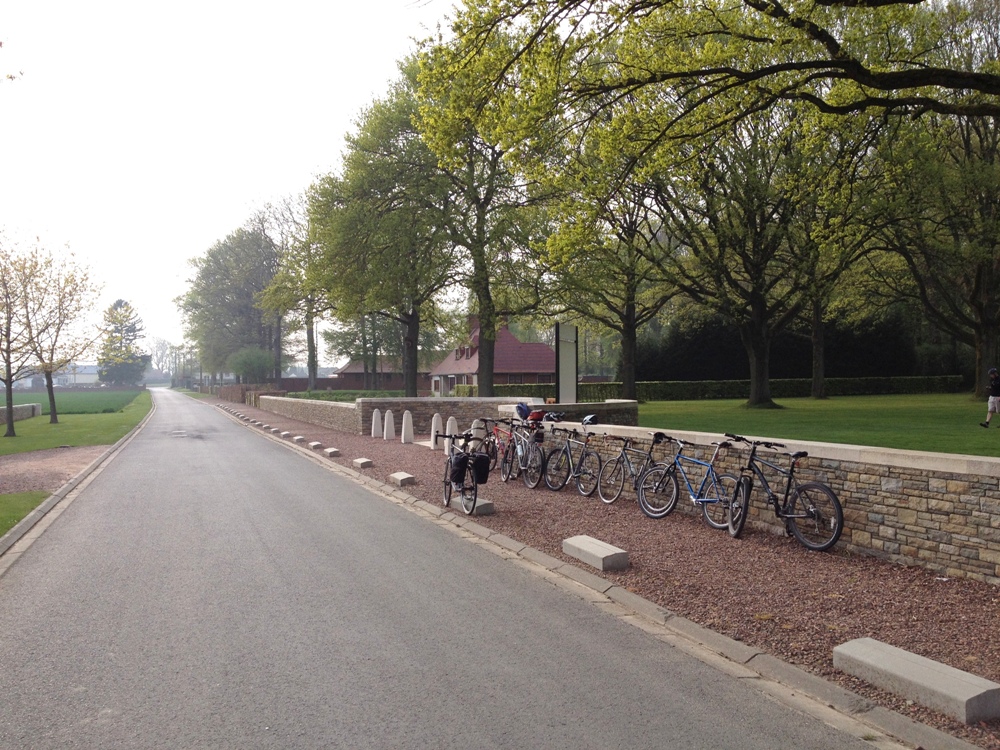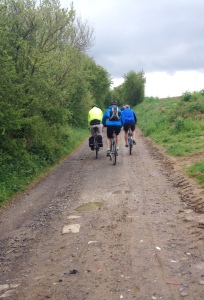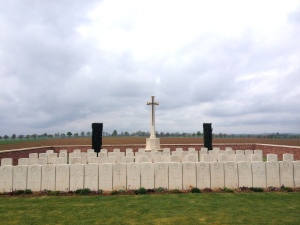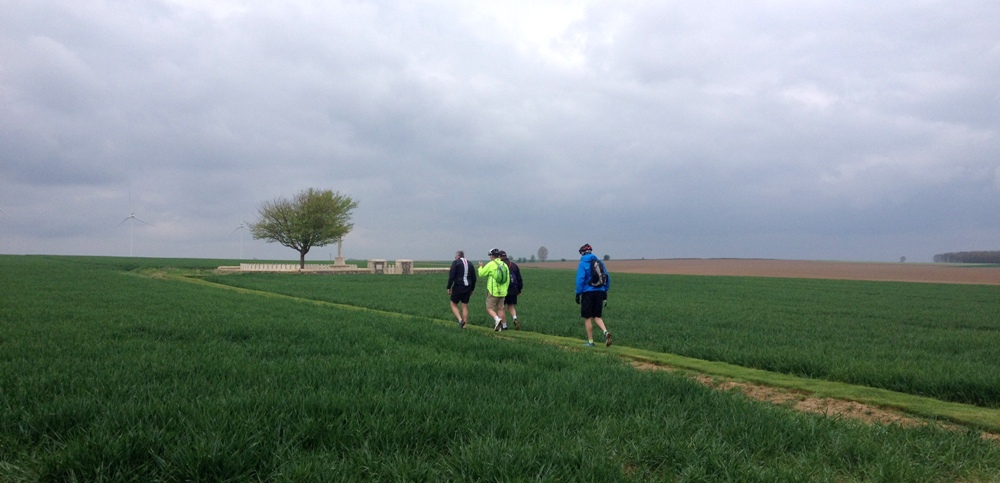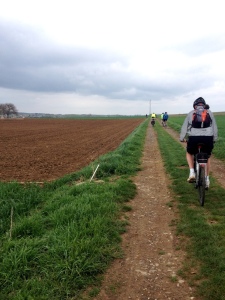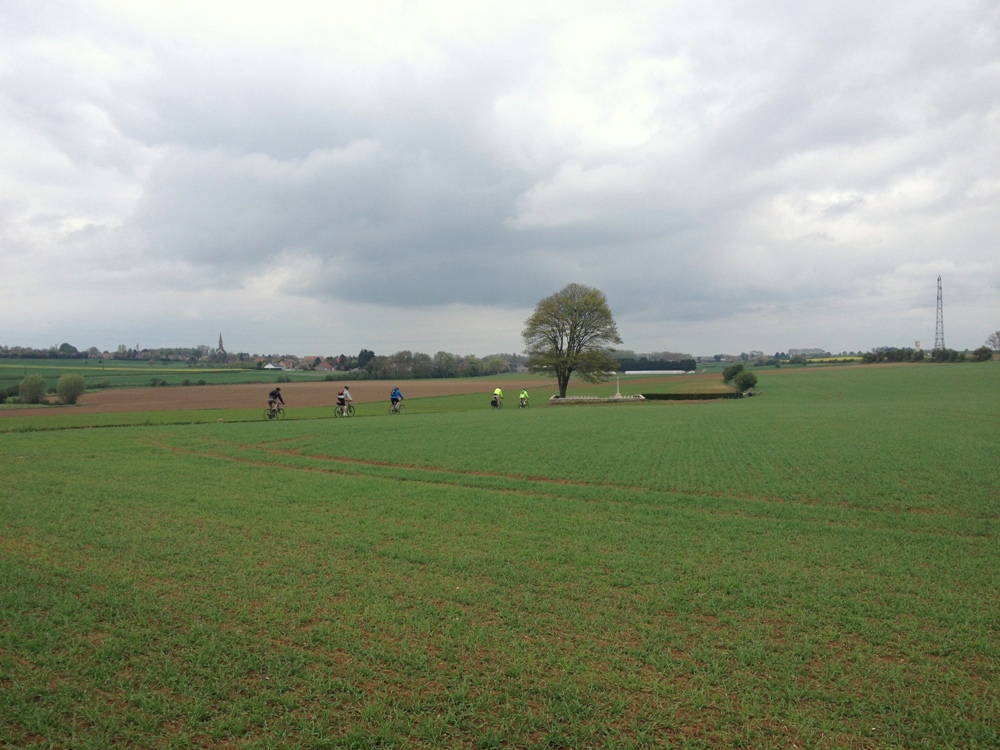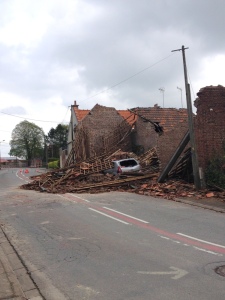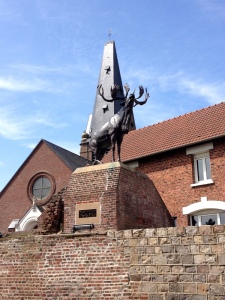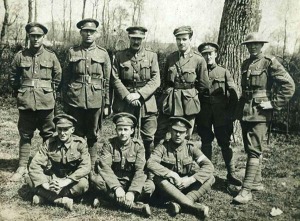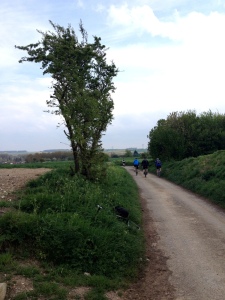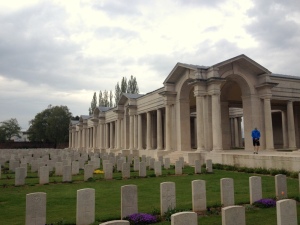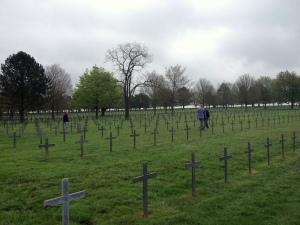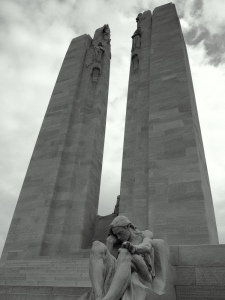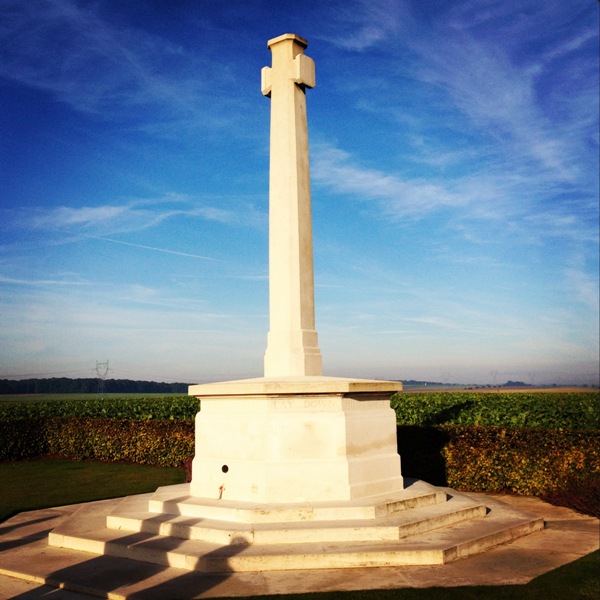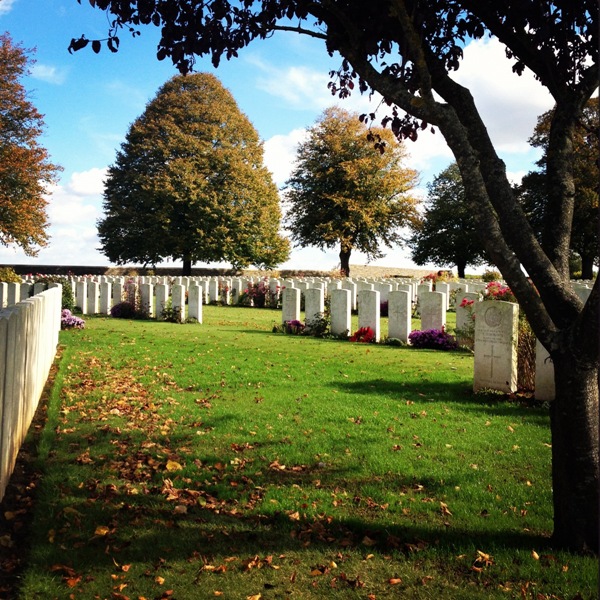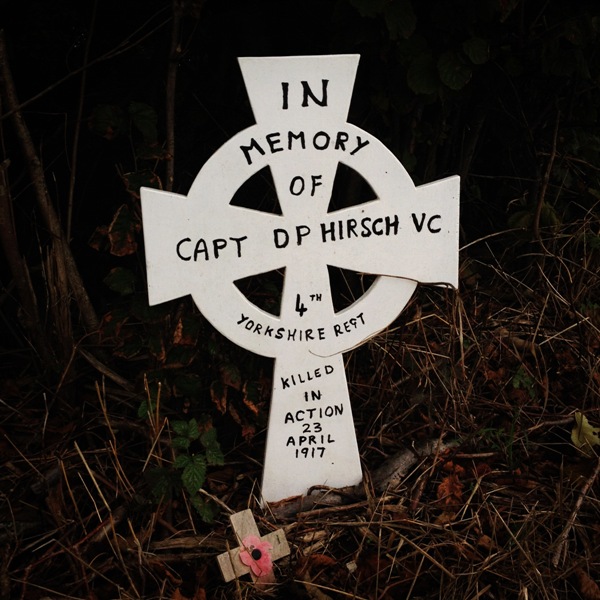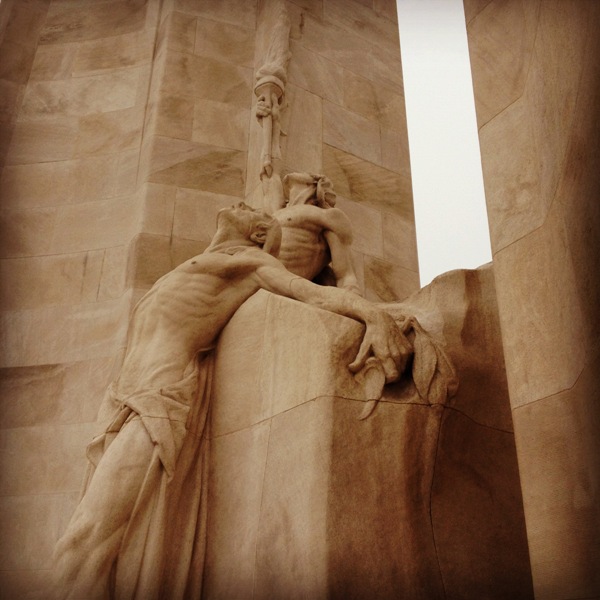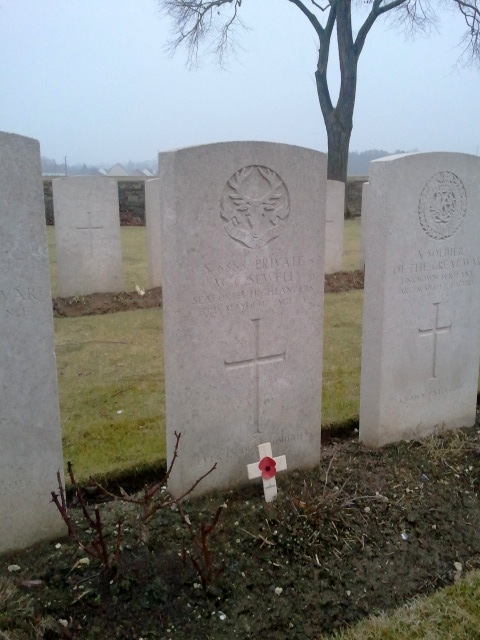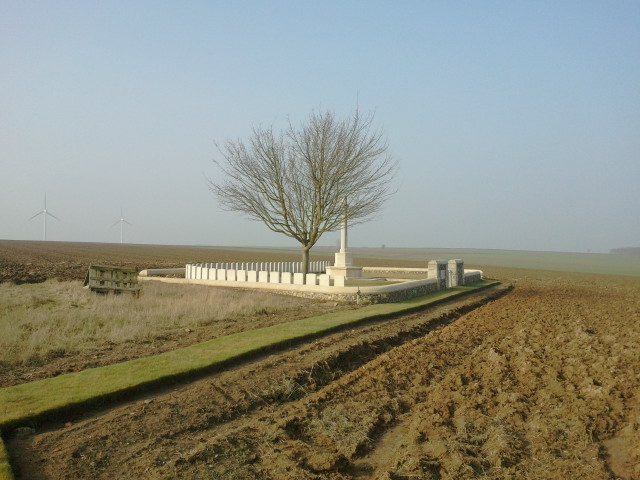Posts Tagged ‘Lesboeufs’
Cycling tour to the Somme and Arras battlefields
Last weekend I had the pleasure of guiding nine gentlemen around the Somme and Arras battlefield on bikes. As a keen cyclist I try and take my bike when visiting the battlefields but this was something different in that it was the first organised specialist cycling trip I had put together.
Our base was the delightfully comfortable Les clés des places in the heart of Arras. The Somme was our destination on Friday, leaving the neglected battlefields of Arras for the Saturday.
Day One – The Somme
Friday morning dawned with beautiful weather. With the bikes fixed to the cars we headed south, crossing the ground voluntarily given up by the Germans as they pulled back to the Hindenburg Line in 1917. Parking at Serre Road Cemetery No.2, we got the bikes ready and headed off.
I had sent our proposed route to the group beforehand so everyone was aware of the distances involved. After an introduction of the battle and practices of the CWGC at Serre Road No. 2 we headed across Redan Ridge with its isolated ribbon of battlefield cemeteries to the small village of Beaumont Hamel. As one of the Somme’s most well visited sites with a highly evocative story the Sunken Lane offered our first chance to get to grips with the actions of July and November 1916. After hearing a 1st Lancashire Fusiliers officer, Lt E.W. Sheppard’s description of the 1 July attack we rode via Auchonvillers to Newfoundland Memorial Park where we had a good walk around the trench system, visiting all three cemeteries. The descent to Hamel was fun; infinitely more so than the climb up the Mill Road to the Ulster Tower! One of the group had previously served in the Duke of Wellington’s Regiment so I was able to show him the Pope’s Nose and discuss the 1/5th Battalion’s attempt to capture the position in September 1916.
After a visit to Lutyen’s imposing Thiepval Memorial and our first (and only) puncture of the day we headed via Mash Valley for lunch at the Old Blighty Tea Room in La Boisselle. Subsequent stops included the Lochnagar mine crater, Becourt, Fricourt and Mametz.
From the bottom of Dantzig Alley Cemetery we surveyed the undulating ground in front of us, a familiar view to the British in July 1916. Dominating the landscape is Mametz Wood, scene of so much heartache and horror for the 17th (Northern) and 38th (Welsh) Divisions. Our tour continued up to Montauban and Trônes Wood before a stop at Guillemont Road Cemetery where we paid our respects at the grave of Raymond Asquith, 3rd Grenadier Guards.
Raymond, the son of the Prime Minister H. H. Asquith has been described as ‘one of the most intellectually distinguished young men of his day’. He had been mortally wounded at the start of the Guards’ attack on 15 September 1916 and died on his way to a dressing station.
One of our group was a former Coldstream Guards officer and so we deviated from the original plan, heading to the Guards Memorial between Ginchy and Lesboeufs. The exposed position on the ridge to Lesboeufs is in the centre of the ground over which the Division fought in the second half of September 1916.
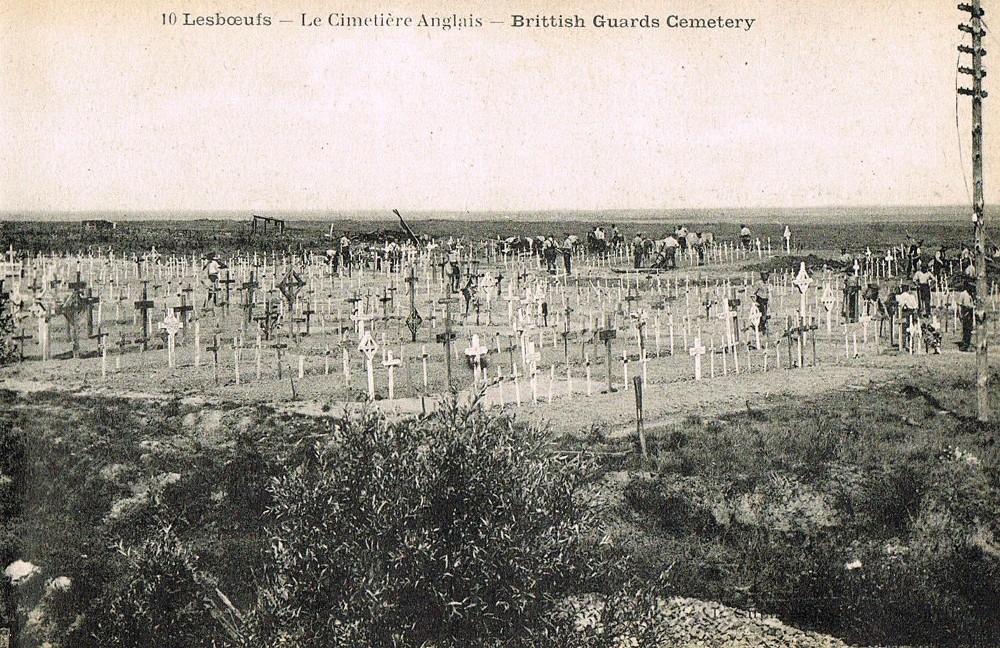
Postwar image of Guards Cemetery, Lesboeufs. The contrast between the haphazard crosses in this postcard and the neat rows of Portland headstones that greet the modern visitor is testament to the skill and dedication of the CWGC.
Our route back across the battlefield took in Delville Wood, looking a perfect picture of peace in dappled sunlight – the polar opposite of summer 1916.
Next up was High Wood where I described the ferocious fighting that had raged there through the high summer of 1916. The wood and Switch Line proved such a bulwark to advance that British efforts resorted to siege warfare techniques; employing Vincent and Livens Large Gallery Flame Projectors in the wood along with the use of tunnellers to plant a mine under German positions. In the late afternoon light of a perfect spring day it was hard to imagine the carnage in these quiet mellow fields and woods.
Crossing the Roman road we headed via Courcelette to Miraumont, along the Ancre valley to Beaucourt before a gentle climb up past Ten Tree Alley en route back to the cars. The conversations that night over a much-needed dinner and drinks all touched on the benefits of cycling in helping everyone’s appreciation of the battlefield.
View this route on plotaroute.com
Day Two – Arras
We awoke the next morning with slightly aching legs and for some, aching heads. There was no need for cars as we would be setting out directly from our hotel. Whilst the touristy spots of the Somme were packed with coaches and school groups the empty fields around Arras are a very different proposition. I assured our travellers that other than farmers and locals we would have the Arras battlefield to ourselves. Heading south via Beaurains (a bike path runs alongside the road for much of this) and London Cemetery we rode to Neuville-Vitasse, a village which in April 1917 was wired into the German defences with the main Hindenburg Line running just behind it.
Heading up the bumpy track to Neuville-Vitasse Road Cemetery was fun. From its dominating position I spoke of the 30th Division’s attack on 9 April 1917, the start of the Arras battle. The closely packed graves of the cemetery are predominantly made up of men from the 2nd Wiltshires and 18th King’s (Liverpool Regiment) who suffered grievous losses attacking across this ground.
I explained the connection with Hugh Dennis’s grandfather, Godfrey Hinnels, whom I had researched for the television programme, ‘Who Do You Think You Are?’ Godfrey’s unit, the 1/4th Suffolk Regiment were tasked with salvage and burial duties in the days after the main attack. As such, it was likely he had been involved with the burial of the men that now lay in the cemetery’s walls.
Next up was Cojeul British Cemetery which is the resting place, amongst others, for two Victoria Cross recipients – Horace Waller, 10th KOYLI and Arthur Henderson, 2nd Argyll & Sutherland Highlanders.
Climbing Henin Hill we visited the remaining German pillbox (MEBU) before our next stop, the isolated and beautiful Cuckoo Passage Cemetery. This small battlefield cemetery, full of Manchester Regiment killed on 23 April 1917 lies at the limit of the Manchesters’ advance. I read aloud an account by Private Paddy Kennedy who served with the 18th Battalion describing events that buy mexican xanax day. Many of his comrades lay around us within the cemetery walls.
We returned back towards Heninel before picking the road up to Chérisy where I discussed the terrible events of 3 May 1917, the Third Battle of the Scarpe. Described by Cyril Falls in the Official History as ‘a melancholy episode’ the attack that day was an unmitigated disaster for the attacking British forces. British dead for the day reached nearly 6,000 for very little material gain.
Why cycling the battlefields is best…
Travelling by bike is by far the best way to appreciate the landscape; you feel every rise, every dip, every change in gradient. What would be a simple drive in a car takes on more meaning when on two wheels. Your thoughts turn irrevocably to the men whose footsteps still echo through the ground as, stealing a line from Sassoon, ‘they slogged up to Arras with rifle and pack’.
Continuing towards Hendecourt our focus changed for a short time as I described the Canadian successes of August and September 1918. Stopping at Sun Valley Cemetery I pointed out the formidable obstacles of Upton Wood and The Crow’s Nest (the latter captured with great daring by the 15th Battalion (48th Highlanders of Canada) on the morning of 1 September 1918). Passing Quebec Cemetery we dropped down for our picnic lunch at the idyllic Valley Cemetery between Vis-en-Artois and Chérisy. This spot is the final resting place of a number of highly decorated officers and NCOs of the 3rd Battalion, Canadian Infantry who were killed nearby at the end of August 1918. Amongst the 3rd Battalion men buried here is the 23 year old Lieutenant Edward Slattery, DCM, MM & 2 Bars. From the decorations received whilst serving in the ranks and his tender age he appears to have been quite some soldier.
Suitably refreshed we headed back towards Guémappe and across the Route National towards Monchy-le-Preux. The road was blocked in the village, the result of a recent building collapse. Undeterred, we headed west where I explained about the village’s capture and the terrible loss of British cavalry in its narrow streets on 11 April 1917.
Having visited the impressive 37th English Division memorial and the Newfoundland Caribou in the village we rode eastwards, up Infantry Hill where I was able to regale the party with the story of the ‘Men who saved Monchy’: the disastrous 14 April 1917 assault by the Newfoundlanders and 1st Essex Regiment.
Infantry Hill is a special spot for me, the scene of so much concentrated fighting and yet, like so much of the Arras battlefield, it remains rarely visited. It was in these fields on 3 May 1917, that disastrous date for the British Army, that one of our group’s great uncles, Private Thomas Clark, 8th East Yorkshire Regiment was killed. Standing close to the spot where the 8th East Yorkshires went over the top I was able to explain the actions that day, reading from the war diary to enable everyone to appreciate the disaster that befell the attacking British troops and the magnificent defensive performance of the German forces.
Extract from the 8th East Yorkshire Regiment after-action report for 3 May 1917 action on Infantry Hill, east of Monchy-le-Preux
The Battalion moved forward at Zero hour [3.45am] but owing to the heavy smoke combined with the darkness they found it difficult to move on any definite point or points.
A platoon commander of the right-hand leading company found himself advancing up a small ridge which is to the south of the copse in O8 Central where he ran up against machine-gun fire. He was joined by a KSLI officer and some men. They moved forward together, the KSLI officer was killed as well as a number of men and as the place was bristling with machine guns and the copse occupied by snipers he stayed down in shell holes, returning at night to HILL TRENCH with 11 men on receipt of orders to do so from Battalion HQ…
…The men were in good heart and moved forward readily. I attribute the results to the heavy smoke, combined with the darkness which prevented people locating their points of direction. In addition to this the enemy barrage was very heavy to which must be added the very effective use of machine-gun both from the front but also enfilading attacking troops.
Casualties: 35 killed, 161 wounded, 39 missing
After some time to contemplate we returned to the village before riding down the Scarpe Valley to Fampoux where we looked at its capture on 9 April 1917 by the 2nd Duke of Wellington’s Regiment. Next up was another special spot; the Seaforth Highlanders cross overlooking the Hyderabad Redoubt, Greenland Hill and Roeux. Whilst there I explained the disastrous 11 April 1917 attack and read aloud the wonderful description left by Seaforth Highlander Private James Stout of events that day.
It is a great shame there is nothing at the former site of the Chemical Works, so bitterly fought over during the battle to show the ferocity of fighting and losses sustained to secure its possession. The site is now a Carrefour mini supermarket where we bought a cool drink and snacks before our ride via Athies back into Arras.
Our final stop of the day was the Arras Memorial where Private Thomas Clark and a further 34,765 men are commemorated. One of the group found the grave of his great uncle in the adjoining Faubourg D’amiens Cemetery. Tired but satisfied at the ground we had covered we headed back to the hotel before a good evening meal and much chat.
View this route on plotaroute.com
Day Three – A quick look north of Arras and back to Blighty
Our final day was overcast and rainy. Bikes were attached to cars before we visited the huge German cemetery at Neuville St-Vaast and French cemetery at La Targette. Next up was the preserved battlefield on Vimy Ridge before our final stop at Walter Allward’s masterpiece, the Vimy Memorial atop Hill 145.
My thanks to the wonderful group who I accompanied and for their generosity and looking after me so well.
If you are interested in a battlefield tour by bike, either as a group or by yourself then please get in touch via the Contact Page. I would be happy to put an itinerary together for any British battlefield and am happy to cycle up to 50 miles/day. However, there is so much to see that 25-40 miles/day is the ideal distance.
Earlier this month I finished an extraordinary week’s work at La Boisselle followed by four days guiding a group of writers around the Somme and Arras battlefields. Last year I had taken Vanessa Gebbie on a bespoke tour following in the footsteps of the 14th Battalion Welsh Regiment (Swansea Pals). She had been extolling the virtues of the battlefields ever since and had cajoled other writers to join her for a few days away.
Somme
After picking up my passengers and hire car in Lille we headed south to the Somme. Our first port of call was to the Glory Hole at La Boisselle where I was able to take my group underground. BBC News were covering our work on site that day and it was exciting to stand at the top of W Shaft and hear the filming taking place below for that night’s Six O’Clock News. Vanessa has written about this on her blog here. After a visit to the Lochnagar Crater we stopped at Becourt Military Cemetery and Norfolk Cemetery en route to our comfortable accommodation at Chavasse Farm, Hardecourt-aux-Bois.
“I can’t tell you what an amazing time I had on our trip. You are a natural – to call you either a historian or a tour guide is to miss the point entirely, I think. You brought it alive for us, you animated the land, the people, the history, in a way I don’t think I’ve ever experienced. There wasn’t one minute when you were talking where I was bored, where I zoned out. You made me want to know everything. And more than that, you inspired me to think about identity, nationality, what I might be prepared to die for.” Tania Hershman
The next day was spent on the Somme starting in the southern sector at the junction of British & French forces between Maricourt & Montauban. Stops that morning included Suzanne Communal Cemetery Extension to visit the graves of 18th Manchester Regiment men killed in May 1916 when German mortar fire blocked their mine shaft at Maricourt, the Carnoy crater field where I explained about the use of the Livens Large Gallery Flame Projector on 1 July 1916, Devonshire Cemetery at Mametz and then down to the impressive Red Dragon of the 38th (Welsh) Division Memorial at Mametz Wood. Despite heavy rain most of us had a walk up the slope from Death Valley to look at positions occupied by the 11th South Wales Borders and 16th Welsh in their unsuccessful 7 July attack on the Hammerhead. After a coffee and change of clothes we headed back out. Stops included Guillemont Road Cemetery, High Wood and the Nine Brave Men (82 Field Company RE) memorial in Bazentin-le-Petit before lunch at Old Blighty Tea Rooms, La Boisselle.
The remains of the afternoon was spent at Aveluy Communal Cemetery Extension, Mash Valley and the Thiepval Memorial to the Missing of the Somme before stopping at Flatiron Copse Cemetery, Mametz on our way back.
Over dinner that night I learnt one of my party had a relative with the 3rd Coldstream Guards who had been killed in the Battle of Flers-Courcelette on 15 September 1916. Our first stop the next morning was on the road between Ginchy and Lesboeufs to look at the starting positions for the attack. Guardsman Ernest Saye is commemorated on the Thiepval Memorial so there was a chance his remains were still lying in the fields before us.
We paid our respects at the Guards Division Memorial, Lesboeufs before a stop specifically requested by Vanessa at Morval British Cemetery. This quiet spot contains 38th (Welsh) Division casualties killed in the capture of Morval on 31 August/1 September 1918. After stops at the Cedric Dickens Cross and Delville Wood Cemetery & Memorial we headed north of the Roman Road to Thiepval to pick up where we had left off the previous day. Stops included the Ulster Tower Newfoundland Memorial Park, the Sunken Lane at Beaumont Hamel and then over the Redan Ridge for a picnic lunch in the majesty of at Serre Road Cemetery No.2 where the Somme part of our tour ended.
Arras
En route north we stopped at Ayette Indian & Chinese Cemetery before arriving at Neuville-Vitasse Road Cemetery, Neuville-Vitasse where I set the scene for the Arras offensive. The elevated position offers a fine viewpoint from which to show the southern sector of the battlefield with Monchy-le-Preux, Henin Hill and the route of the Hindenburg Line clear to see.
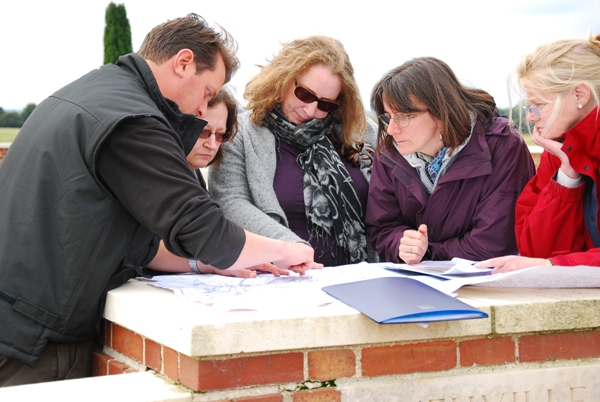
Poring over maps of the Arras battlefield at Neuville-Vitasse Road Cemetery. Thanks to Vanessa Gebbie for her permission to use this image.
After a visit to Cojeul British Cemetery to pay our respects at the grave of two Victoria Cross winners, Private Horace Waller and Captain Arthur Henderson we headed up to the open windswept ground of Henin Hill where we had a good look around a surviving German ‘mebu’ concrete pillbox, part of the Hindenburg Line defences in the area. After repeatedly getting in and out of the car we were keen to stretch the legs and so took a walk to Heninel-Croisilles Road Cemetery where I read the poet Siegfried Sassoon’s account of being wounded nearby. We then walked down to Rookery Cemetery and Cuckoo Passage Cemetery.
Our next stop was on Wancourt Ridge outside Wancourt British Cemetery where I read John Glubb’s detailed account of the bridging work undertaken by 7 Field Company RE across the River Cojeul in the valley before us on 23-25 April 1917. The landscape is wonderfully easy to match up to Glubb’s descriptions and offers the chance to imagine the scene 95 years ago. Afterwards some of us walked up to the site of Wancourt Tower. Our final stop of the day was the rarely visited but rather beautiful Vis-en-Artois Memorial. One of our party Caroline had a relative commemorated on the panels. Percy Honeybill, 1st King’s Own (Royal Lancaster Regiment) was killed on 2 September 1918 attacking the Drocourt- Quéant defences.
Our final day saw us head to Arras for a croissant and coffee breakfast in the Petite Place before a visit to the Arras Memorial to the Missing and Faubourg-d’Amiens Cemetery. We then headed out along the Arras-Cambrai road to find the spot between Guémappe and Cherisy where Third Army Panorama No. 556 was taken on 6 May 1917. Standing close to the spot where the image was taken it offers an ideal opportunity to visualise battlefield conditions in May 1917. Our next stop was at Kestrel Copse to see the new cross for Captain David Hirsch VC. We then headed north to Monchy-le-Preux where I explained the magnificent action which resulted in the capture of the village on 11 April 1917. One of our party’s grandfather had served in the Essex Yeomanry. I was able to show her Orange Hill and the fields which her grandfather would have galloped across on 11 April 1917. We then headed up Infantry Hill where I told of the disastrous Newfoundland and Essex Regiment attack on 14 April and the subsequent action by the “Men who saved Monchy”.
Crossing the River Scarpe to Roeux, we visited the site of dreaded Chemical Works, now a benign Carrefour supermarket and garage. I always find it a pity that there is nothing on the site to show the ferocity of the fighting here in April and May 1917. Lunch was taken in Sunken Lane Cemetery at Fampoux (written about here by Vanessa Gebbie ). We discussed the terrible fighting for Roeux and the 11 April attack by the 2nd Seaforth Highlanders and 1st Royal Irish Fusiliers. After visiting Gavrelle we headed north to Vimy Ridge, visiting the trenches and Walter Allward’s masterpiece, the Vimy Memorial where we bumped into my brother Mark guiding a group. What a small place the battlefields are sometimes! There followed an interesting journey back to Lille Europe station where the car was returned in a rather muddier state than it had been when picked up.
My thanks to Vanessa, Tania, Zoe, Angela and Caroline for being such good company and making the trip such a delight. I am already planning the itinerary for 2013!
“Thank you is really an inadequate word to convey my feelings about the weekend. I still feel as if I’ve been to a different place and had my life changed. I’m not quite sure how you managed it but it felt as if you really took us back in time to 1914, 1916, 1917 and 1918 and that we were standing alongside the men waiting for the whistles to send them over the top and later dragging or rolling themselves back to the safety of their trenches. I thought I knew a bit about the First World War having done a history degree and having read the poetry. At an intellectual level I suppose I did know about the war but emotionally I had no idea what it was like for the men and that experience was what you gave us with the maps, the panoramas and all the stories. Over the last few days they lived and breathed again. It’s difficult to pick out my favourite moments as everything felt like a highlight. I can’t remember if it was Tania or Zoe who said they’d never before come across a guide who didn’t bore them for a second. Actually ‘guide’ isn’t the right word – the ‘expert’ comes closer but also the ‘enthusiast’ brimming over with things you wanted to share.” Caroline Davies
From 2 – 4 March I was guiding a private battlefield tour. Late last year I had been asked to compile a report on S/8888 Private William Charles Sewell who served in the 2nd Battalion Seaforth Highlanders. William Sewell went overseas in November 1915, served through the Somme in 1916 and was killed at Roeux during the Battle of Arras on 3 May 1917. As well as compiling a detailed report on William Sewell’s war service I was asked to take his great nephew, Paul Carter with his friends to follow in William’s footsteps from Arras down to the Somme.
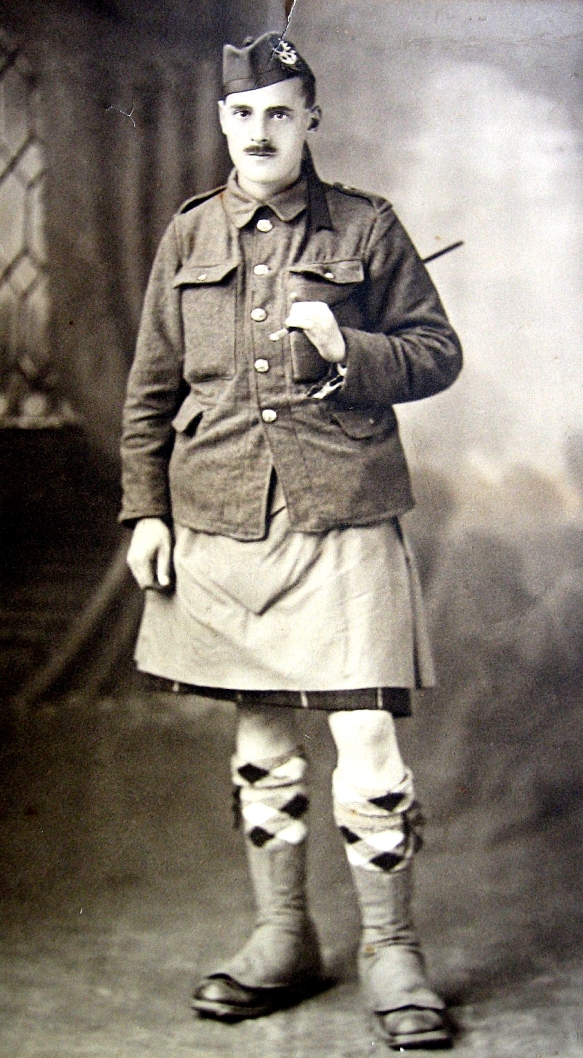
Private William Charles Sewell, 2nd Battalion Seaforth Highlanders. Killed 3 May 1917 during an attack at Roeux during the Battle of Arras. Many thanks to Paul Carter for his permission to use this photo.
Despite a distinct lack of decent weather for the entire trip we had a wonderful time and it was a real honour to be guiding the first member of William Sewell’s family to ever visit his grave. Starting at Vimy Ridge and the Memorial Park we began our tour of the Arras battlefields. After a stop at La Targette for the enormous French and German cemeteries we picked up the Athies road, following in the footsteps of the triumphant 9th (Scottish) Division in their advance on 9 April 1917. After a quick stop at Point du Jour Cemetery and the 9th (Scottish) Division memorial we headed to Fampoux, tracing the route of the 4th Division as they leapfrogged the Scots that day. Stopping at the Seaforths Cross at the Sunken Lane I explained the disastrous attack on 11 April 1917 and read an account of the operation from Private James Stout, a survivor of the attack. As one of those actions that holds a particular fascination for me it was all the more poignant being there with a relative of a soldier who may well have taken place in that ill-planned venture. The following account provides a bleak picture of subsequent events:
At ZERO Hour (12 noon) 2nd Seaforths and 1st Royal Irish Fusiliers advanced, the former on a 3 company front, the latter on a 2 company front. The 2nd Seaforth Highlanders’ objective was the cross roads I.13.a.9.3, exclusive to cross roads I.7.a.4.3 exclusive. Immediately these two battalions advanced, they came under a very heavy machine gun fire from the INN, CHEMICAL WORKS, STATION, CHATEAU and Railway Embankment. The whole ground in Squares H.12 and 18 appeared to be swept by machine gun fire.
At the same time a barrage was put down on FAMPOUX and East of the SUNKEN Road where the remaining two battalions were assembling. This machine gun fire very soon thinned the advancing lines but the troops continued to advance.
On the left, part of a company of the 2nd Seaforth Highlanders entered a new trench some 150 to 200 yards west of the 1st objective, about I.7.c.5.9.
This party under an officer [Lt Donald Mackintosh] maintained itself in the trench for some time, until its ammunition was exhausted, when they were forced back by a counter attack and only a few returned. The remainder, including the officer who is missing, were either killed or wounded, and left in this trench.
The heavy machine gun fire maintained by the enemy made it impossible to obtain information regarding the course of the action but it required no report that a single wave of 400 men who had to advance an average distance of 400 yards with a Battalion front of 1100 yards could not obtain their objectives in face of such machine gun fire and rifle fire.
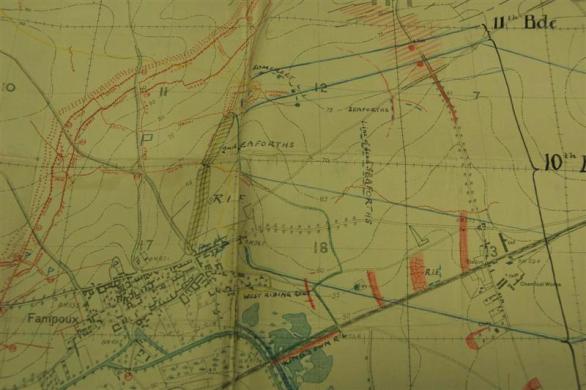
Map extract from 10th Brigade war diary showing 'line of dead Seaforths'. Ref: WO95/1479 10th Infantry Brigade War Diary. Copyright National Archives & reproduced with their permission.
After the debacle of 11 April 4th Division went back for some rest. Their next large-scale attack was the fighting at Roeux on 3 May. It was during this fighting that William Swell was killed. Starting next to the A1 motorway at Crump Trench Cemetery we followed the battalion through their part in the battle. The following map shows the objectives, named respectively the BLACK, BLUE and RED Lines. The total advance was so far as the 4th Division was concerned was to cover a distance of 2500 yards, including:
- The capture of the Northern portion of the village of ROEUX, including the CHEMICAL WORKS and STATION buildings.
- The capture of the trench system on the high ground near HAUSA and DELBAR Woods, and finally
- The piercing of the defences round PLOUVAIN, which were partially wired.
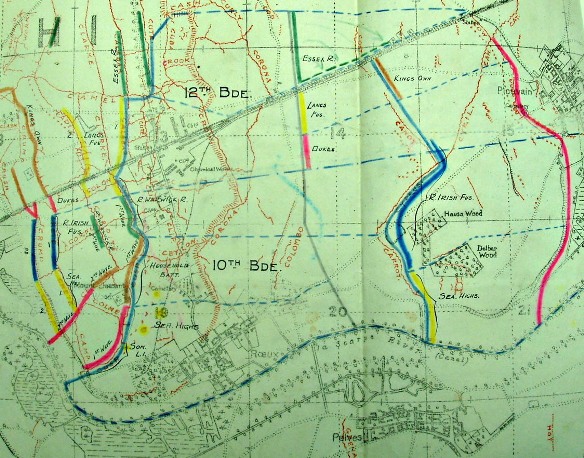
3 May 1917: the 4th Division's attack plan for Roeux . Positions for the 2nd Seaforths can be seen marked in yellow. Ref: WO95/1446 4th Division War Diary. Copyright National Archives & reproduced with their permission.
Of the attack, the war diary notes:
3 May – Zero hour 3.45am when a heavy bombardment of enemy’s position started, lasting for half an hour. Barrage then crept forward very slowly. Battalion left their trenches at 4.30am, being in support to the Household Battalion who were to capture the cemetery north of ROEUX. The Royal Warwickshire Regiment were on the left of the Household Battalion and Royal Irish Fusiliers on left of Seaforths, support to Royal Warwickshire Regiment. 1st Somerset Light Infantry were on the right and were to capture village of ROEUX. On reaching BLUE Line which was just west of DELBAR WOOD the Battalion moved to their right until left of each wave was opposite NW corner of DELBAR WOOD where a halt was made until ZERO + 85 = 5.10am when they advanced to capture the RED line, east of DELBAR and HAUSA WOOD, and immediately west of PLOUVAIN, through I.21.b. and I.15.d & b. This attack unfortunately failed owing to both flanks being held up and severe losses, and later on the whole Brigade line was forced to withdraw to original front line. The Battalion came back to CRETE Trench. This was the position until dark when the Battalion was sent to relieve the Household Battalion in CEYLON Trench from its junction with CORONA Trench I.19.a.8.7. to its junction with COX Trench I.19.a. 7.3. Company Sergeant Major Fraser was in charge of the line as all officers taking part in these operations had become casualties. The Commanding Officer, Adjutant, Medical Officer and three other officers became casualties of the same shell.
Delbar and Hausa Wood no longer exist. Le Lac Bleu (Blue Lake) now covers the ground on which the woods sat. Unless there is specific personal testimony it is notoriously hard to pinpoint the exact spot that a soldier was killed. However, as most casualties were sustained between the BLUE and RED lines it seems likely that William Sewell was killed in this area. Having followed the route of advance we returned to the ground between Fampoux and Roeux to pay our respects at William Sewell’s grave.
Crossing the Scarpe we drove up in Monchy-le-Preux and up Infantry Hill where I recounted the story of 14 April attack by the 1st Essex and Newfoundlanders and the resulting action of the small band of men who saved Monchy from German recapture. For our last stop of the day we headed to the Arras Memorial to Missing.
Next morning began with a windswept walk on the Hindenburg Line to the quiet delight of Rookery Cemetery and Cuckoo Passage Cemetery, the latter full of men of the Manchester Regiment killed on 23 April 1917.
We then headed back into Arras for a good tour of the underground boves and tunnels at Wellington Quarry. Our brief visit to Arras was now at an end as we headed south down to the Somme battlefields.
Our first stop was the Sheffield Memorial Park and the Gospel Copses at Serre (the 2nd Seaforths held the frontline trenches here in November – December 1915). We then headed to Redan Ridge to look at the part played by the 2nd Seaforths in the opening day of the Battle of the Somme, 1 July 1916. The operation plan was for 11th Brigade to take Munich Trench and then for 10th and 12th Brigades to pass through them at a given time and gain the final objective along the Beaucourt Ridge (2nd Seaforths were part of 10th Infantry Brigade)
The war diary offers the following explanation of events:
Zero at 7.30am. From 5.30am the very intense bombardment concentrated on the German trenches in front. At 7.30am the 11th Brigade moved forward from our front in waves.
By 8.45am no messages had come through from 11th Brigade. Patrols advanced and were met by heavy machine gun fire. Telephone to Brigade HQ was out so two orderlies were sent for orders. As they had not arrived by 9am – the hour appointed for the Battalion advance – the remainder of the Battalion moved forward.
On coming into view of the German trenches the Battalion came under heavy machine gun fire from the front and direction of Beaumont Hamel. After passing the German front, parties pushed forward and reached the third line of trenches. Other parties of our men may have reached Munich Trench but there was no possible communication and none returned.
By this time 11th Brigade had already lost their Brigadier, General Prowse (died of wounds) and all four Commanding Officers (killed). Enemy held first, second and third lines on our left and right. Attempts were made to consolidate the ground gained. Enemy bombed on flanks and the third line was given up at about 1pm.
By 11am there were only 5 officers left with the battalion and casualties were proportionately heavy in the ranks. During the evacuation of the third trench Drummer Ritchie sounded the Charge with the idea of encouraging these waverers who had lost their leaders. This gallant action in addition to his conduct throughout the day gained him the Victoria Cross.
We finally withdrew at about 5pm to original front line positions south of the Quadilateral. At this time there were about 40 men of the battalion left.
The war diary records the following casualties:
| Officers | Other Ranks | |
| Killed | 12 | 59 |
| Died of wounds | 1 | 6 |
| Wounded | 8 | 260 |
| Missing, believed killed | 0 | 1 |
| Missing | 0 | 53 |
| TOTAL | 21 | 379 |
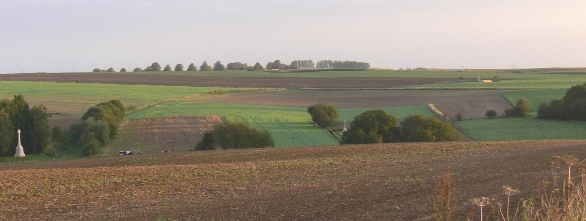
Redan Ridge viewed from a position on the Hawthorn Ridge. The German-held village of Beaumont Hamel is to the right of frame.
Further stops that afternoon included the Sunken Lane at Beaumont Hamel, scene of the infamous attack by 1st Lancashire Fusiliers on 1 July, Newfoundland Memorial Park with its preserved trenches and the Ulster Tower and Thiepval Memorial to the Missing. We finished by following the front line by Authuille Wood to Ovillers, down Mash Valley and then to the hotel at Albert.
Our final day dawned in thick fog which made pointing out sites rather difficult. Beginning with a stop at Fricourt and the Bois Francais we followed the British front line and saw the site of Siegfried Sassoon’s Military Cross action before heading to the site of the Livens Flame Projector site at Mametz. Dropping down to Devonshire Cemetery we headed toward Maricourt and the junction with the French Army on 1 July. Passing Trônes Wood, Guillemont and Ginchy we headed to the desolate fields between Lesboeufs and Le Transloy for our last in-depth look at the part played by the 2nd Seaforths during the Somme battle. Fighting in desperate mud with a thick mist (not unlike the weather on the day we visited) the battalion took place in two attacks in mid-October against German positions in Dewdrop and Rainy Trench. The Battalion war diary recorded the ground conditions in the area:
From Montauban eastwards the whole country is one stretch of absolute desolation – a more gloomy sight I have never seen. The ground is just a maze of shell holes, varying from size of stokes mortar crater to the size of a crater made by a 15-inch.
The attacks on the 14th and 23rd were pressed with utmost gallantry but typical resolute defence from German troops allied to the dreadful ground conditions encountered made any serious advance impossible.
After a walk around Delville Wood and a stop at Flat Iron Copse Cemetery and the Welsh Dragon Memorial at Mametz Wood we ended up at the Glory Hole at La Boisselle where I was able to show them around site and take them underground in W Adit. It had been a real pleasure spending time with these gentlemen. Thanks to Paul Carter and his friends Tim Halliday, Al Kendall and Richard Johnson for making me so welcome. I hope that we can do it again sometime soon – perhaps Ypres next time?
Thank you very much for the wonderful report on my Great Uncle William Sewell and the tailor made trip following in his footsteps 97 years later. Your local knowledge, historical expertise and professional service gave my small group a fantastic tour- better than we could have hoped for. The stories of individual’s personal experiences brought an extra dimension to the trip and brought to life briefly a few of the thousands of names inscribed on memorial walls or grave stones. We all agreed that trip would have been so much less of an event if we had tried to find our own way around, and we would have missed so many significant points. The battlefield overlays and WW1 panoramas were fantastic to relate to as we stood in the centre of all those events and you recounted the events played out. On our journey back there was plenty of talk about the next trip – until then! Paul Carter
I know all four of us found the experience fascinating, thought provoking, educational and frequently moving as well. Your own passion and knowledge of a crucial era in our history was captivating and I am sure like me, the other guys have been singing your praises to those they have talked to about the trip. It certainly was a weekend to remember. Al Kendall

